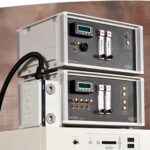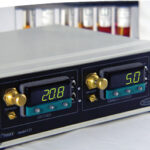 Cytocentric Visionaries: Lauren Zenewicz, University of Oklahoma Health Sciences Center
Cytocentric Visionaries: Lauren Zenewicz, University of Oklahoma Health Sciences Center
Don’t Miss Your Cells’ Phenotype by Using Inappropriate Room Air Oxygen
Dr. Lauren Zenewicz is an Assistant Professor in the Department of Microbiology and Immunology at the University of Oklahoma Health Sciences Center. Her lab studies Interleukin-22 and its role in the inflammation and disease. She published a recent article in Frontiers in Immunology on in vitro oxygen levels during immunological studies [1]. In this article, she proposes that oxygen be considered a microenvironmental trigger for immune cell signaling.
Alicia Henn: I saw your article in Frontiers in Immunology last week. You are a uniquely Cytocentric voice, drawing attention to the importance of oxygen in vitro. What madeyou look at in vitro oxygen in the first place?
Lauren Zenewicz: We are interested in mucosal immunology and interleukin-22 (IL-22). For IL-22, it came down to two main things. It is protective at times so you want to make it during infection, but too much of it for too long is bad.
IL-22 is made by immune cells and is recognized by tissues. It is important to maintain epithelial barriers in the GI tract and in the lung, especially during acute infection when it causes cell proliferation. However in models of much longer, chronic diseases like inflammatory bowel disease or colon cancer, IL-22 causes too much proliferation. You see hyperplasia which leads to immunopathology or more tumors.
So we wanted to study what turns IL-22 on and off. There are a few known triggers, but clearly there has to be other sensors for the cell to know that they are in an inflammatory environment. Oxygen seemed like a good environmental sensor.
There are two known major transcription factors for IL-22. One of them is aryl hydrocarbon receptor (AHR) which is essential for inducing IL-22 in T cells. If you knock it out, a cell makes little IL-22. It recognizes environmental polycyclic aromatic hydrocarbons, small molecules like dioxin. It binds these ligands, translocates to the nucleus and binds to its partner, ARNT, forming a complex and turns on genes.
That binding partner, ARNT, has another name, HIF-1beta. It is the same binding partner that HIF-1a, the hypoxia-inducible factor, uses. So there were potential links to oxygen through using shared signal transduction pathways.
AH: Watching this new field of Immunometabolism emerge, do you think Immunology is standing on the shoulders of those that studied cancer and tumor hypoxia?
LZ: I give a lot of credit to cancer biologists over the last 20 years for figuring out the HIF pathway. If it hadn’t been for cancer biology, we wouldn’t have the understanding that we do today. Immunology has really benefited from this knowledge
Old questions get revisited as we get new tools. You couldn’t study the role of HIF 25 years ago because the gene deletions in mouse models were embryonic lethal. Now, with the conditional deletions and reporter mice that we have, we can answer more questions about HIF and cytokines or immune cell development than we could even a few years ago.
AH: Did you think that groups working on in vitro cultured immunotherapies such as CAR-T and hematopoietic stem cells should be considering oxygen for their patient cultures?
LZ: When it comes to CAR-T and HSC culture in vitro, I think monitoring oxygen levels is really important. My guess is that harvest oxygen levels as well as oxygen culture levels are important to cell viability. Systemically testing the effects of oxygen on cell harvest and culturing should be a high priority.
AH: How much is too much oxygen for immune cells?
LZ: Hypoxia we consider to be very low, like 1%, but physiologic oxygen can be hypoxic compared to your traditional CO2 incubator. Who knows if your protein of interest is being expressed the way it should be? The conditions may miss or exaggerate some phenomena.
When you start thinking about the actual oxygen levels of most tissues, bone marrow and the spleen, it seems like they are getting too much oxygen in the incubator.
They aren’t trivial experiments. We constantly check cell viability. We incubate cells for 24 hours at 1% O2and our viability is usually really good. What I worry about is that people miss phenomena that you would never see unless you were actually at physiologic oxygen conditions.
If you can’t find a phenotype, it could be the way that you are doing the experiment. Maybe the environment isn’t right. Whatever your hypothesis is, a nutrient, surface marker, cell-cell interaction marker, whatever it is; you could be missing the phenotype you are looking for because it may be different in physiologic oxygen conditions. In terms of protein expression or cellular function, physiologic oxygen, even physiologic hypoxia, is very different from the incubator.
I’ve done some calculations. How different would the atmospheric oxygen be between a lab at sea level, like New York or Boston, and a lab in Denver, a mile high? It actually was a couple of percentages. It makes me wonder if the atmosphere is one that factors that causes differences in phenotypes between labs.
There are a lot of factors that cause differences other than oxygen, like medium: how old it is, different lots of sera. There are lots of little cosmic things that we have found that if you do it this way, it works, so we keep doing those things. If the cell culture medium bottle has been open for more than two weeks, we do not get as good IL-22 expression from T cells. It doesn’t matter how long it has been in the fridge, but what only matters is how long it has been opened to room air. There may be a role there for oxygen or something else in the air.
When it comes down to recapitulating the best environment, immunologists should be using 5% oxygen for most immunological studies, unless they study respiratory biology.
AH: What are the next projects for your lab?
LZ: We are currently looking at other HIF family members as well as HIF-1 alpha. We are looking at getting more into the immunometabolism of the control of IL-22. Oxygen is important, glucose is important, signals like mTOR are important.
It comes down to knowing what is important for control because there are no treatments that directly target IL-22, but there are drugs for chronic inflammatory conditions that influence it, like antibodies for IL-6 and IL-23 that might be able to help patients. Understanding the environmental factors that regulate cytokine expression is important.
There are always new tools and new ways to look at things. We don’t know what they are going to find in the future. We are always finding more.
AH:We will be watching your work as you progress, Dr. Zenewicz. Thank you for bringing attention to this critical issue and thank you for your time and your insights.
If you would like to be featured in our Cytocentric Visionary Series, contact us. We would love to hear about your work.
1. Zenewicz, L. A. Oxygen Levels and Immunological Studies. Frontiers in immunology 8, doi:10.3389/fimmu.2017.00324 (2017).
Recent Articles

Cytocentric Visionaries Hal Broxmeyer
Cytocentric Visionaries: Hal Broxmeyer November 27, 1944 ~ December 8, 2021 Hal Broxmeyer telling Randy Yerden about his latest findings in June 2016. The average height of the Cytocentric researcher has been reduced, now that we have lost a giant. Hal Broxmeyer died...

Cytocentric Visionaries: Dr. David Gozal, MD – Part Two
Cytocentric Visionaries: Dr. David Gozal, MD Part 2: COVID-19 Research, Prone Positioning, and Chronoadequacy Alicia Henn, PhD MBA, Chief Scientific Officer, BioSpherix David Gozal, MD, MBA, PhD (Hon) is the Marie M. and Harry L. Smith Endowed Chair and Chairperson of...

Cytocentric Visionaries: Dr. David Gozal, MD – Part One
Cytocentric Visionaries: Dr. David Gozal, MD Part 1: COVID-19, ACE2, and the Circadian Clock Alicia Henn, PhD MBA, Chief Scientific Officer, BioSpherix David Gozal, MD, MBA, PhD (Hon) is the Marie M. and Harry L. Smith Endowed Chair and Chairperson of the Department...
About The Author
Alicia D Henn, PhD, MBA
Chief Scientific Officer of BioSpherix, Ltd
Alicia Henn has been the Chief Scientific Officer of BioSpherix, Ltd since 2013. Previously, she was a researcher at the Center for Biodefense Immune Modeling in Rochester, NY. Alicia obtained her PhD in molecular pharmacology and cancer therapeutics from Roswell Park Cancer Institute in Buffalo, NY and her MBA from the Simon School at University of Rochester in Rochester, NY.
If you would like to be featured in our Cytocentric Visionary Series, contact us. We would love to hear about your work.





































